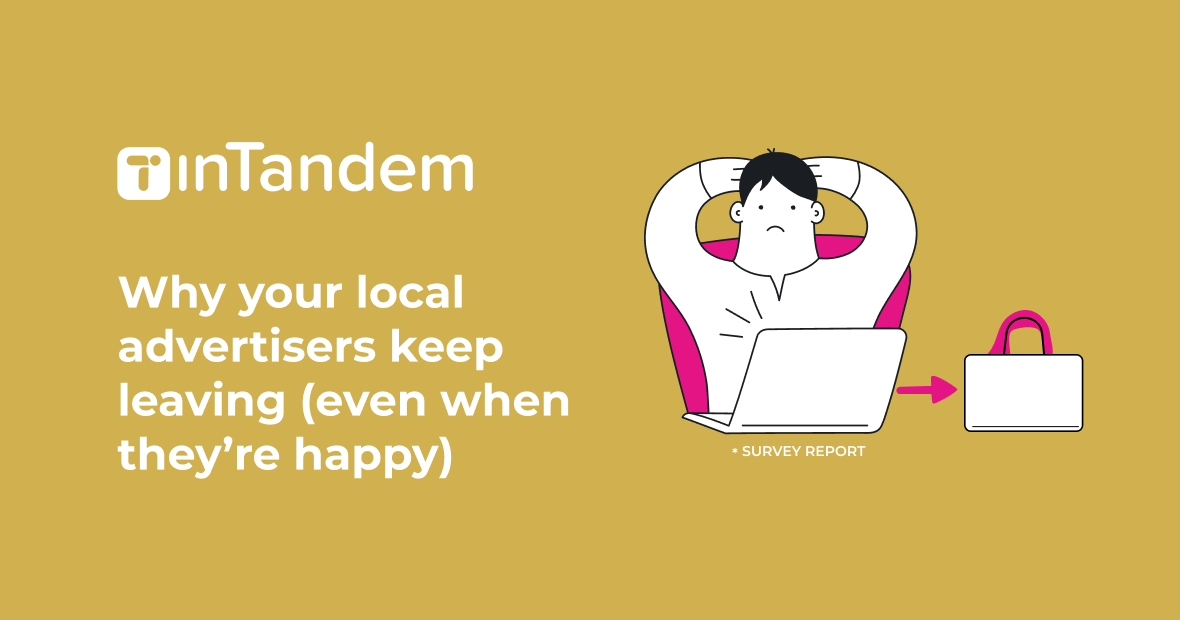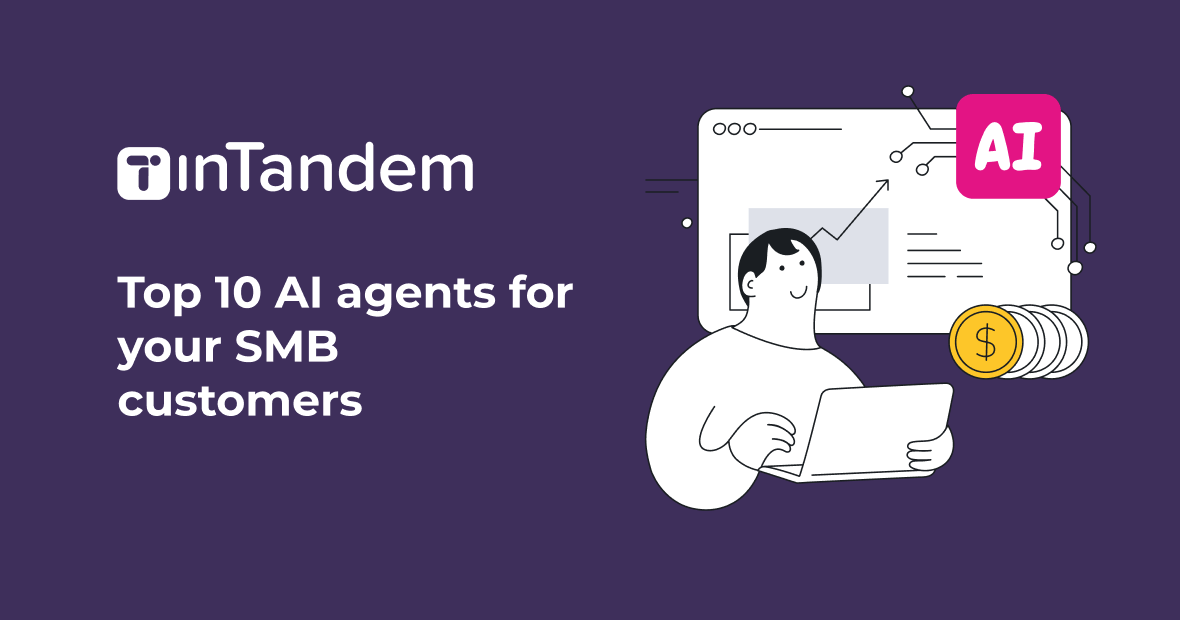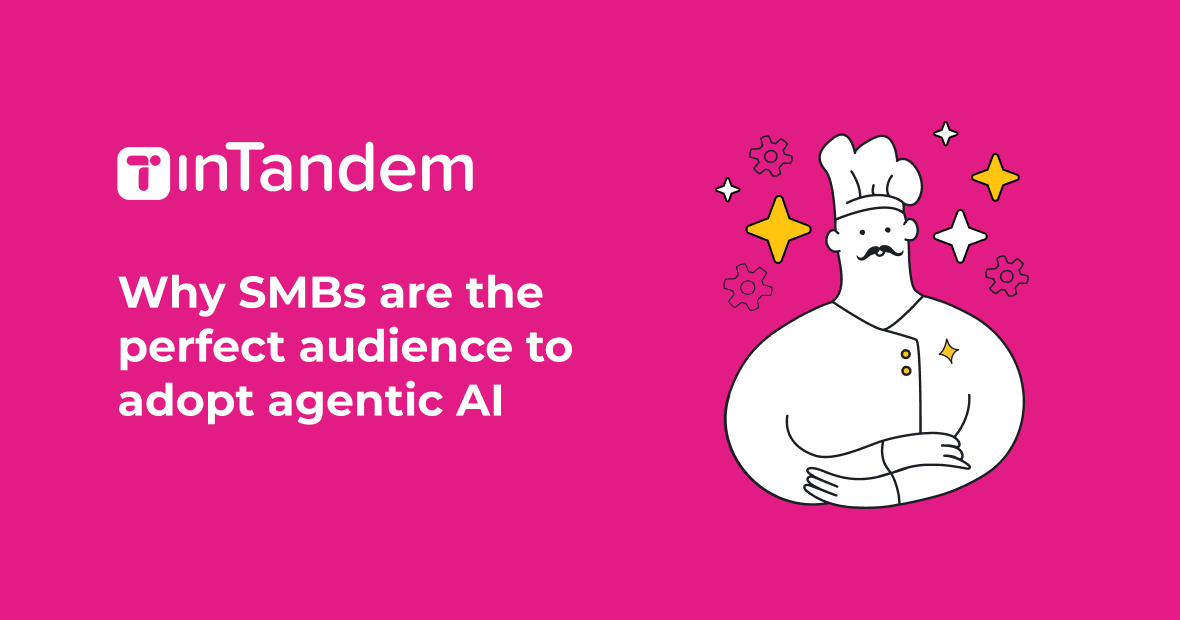The statistics speak for themselves: over 350 million small and medium-sized businesses (SMBs) worldwide account for more than 90% of all companies, generate around 70% of global employment, and contribute between 50% and 70% of GDP, depending on the country. Yet despite their scale and economic impact, SMBs remain significantly underserved by solution providers such as financial institutions, marketing and media companies, and telcos, making this market segment one of the largest and most overlooked business opportunities today. Can technology, and specifically AI, help with changing this?
SMBs are increasingly investing in digital tools to stay competitive and profitable. Our latest survey shows that 67% of SMBs added up to four new core business tools in 2024 alone, beyond essentials like email or social media. The opportunity with this market segment is enormous. But so are the challenges.
SMBs have limited attention spans, high price sensitivity, and low brand loyalty. 60% of small businesses will switch providers after a single price increase. These factors, combined with the diversity and volume of the SMB sector, make it harder than ever to successfully and consistently build and grow a thriving SMB-focused business at scale.
To truly stand out and create deeper, longer-lasting customer relationships, vendors, platforms, and organizations serving SMBs must find the right balance between personalization and scale, and Agentic AI is quickly emerging as an answer. Agentic AI refers to autonomous AI systems that automate complex workflows, reduce unnecessary overhead, and improve decision-making to achieve business goals.
More and more companies are offering AI agents to their SMB customers, but without a deep understanding of SMB needs, these agents often come with a steep learning curve and deliver limited value early on. Instead of simplifying operations, too many AI-powered solutions demand time, training, and attention SMBs simply can’t spare.
In this article, I’ll go over the AI adoption gap and challenges in the SMB sector, the pitfalls of “AI silos”, and how Agentic AI can be effectively unleashed to bridge the adoption gap, drive meaningful growth, and offer maximum value for SMBs and the organizations that serve them.
SMBs are lagging in AI adoption
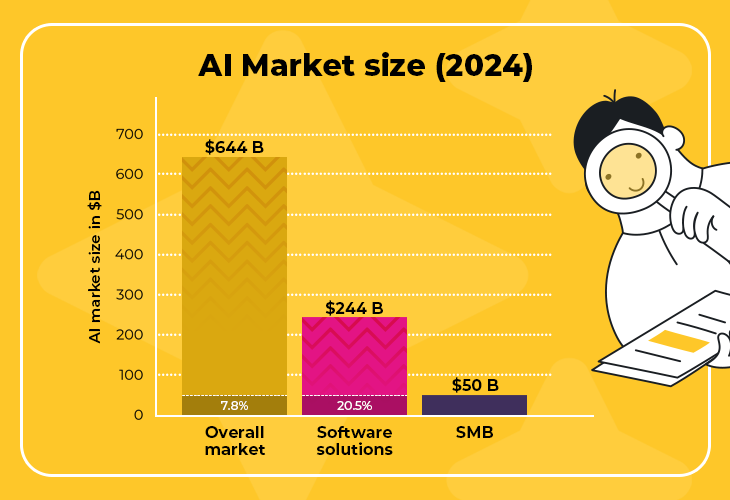
While SMBs play an outsized role in the global economy, contributing up to 70% of global GDP, they currently represent just 8% of the total AI market and 20% of the AI software market. Why?
There’s no question that SMBs see the value in AI. In fact, according to our annual SMB surveys, perceptions are shifting. In 2023, the most common reason SMBs cited for not adopting AI was, “I don’t feel it would help my business.” By the end of 2024, that had changed significantly. The leading reason became, “I don’t know how to use it.”
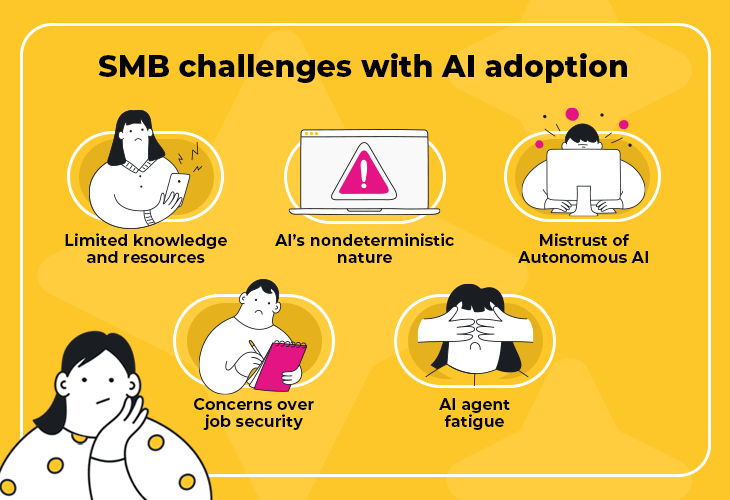
This shift highlights an important insight: SMBs increasingly recognize the benefits of AI, but many still lack the knowledge, expertise, and confidence to adopt it effectively. A few key challenges stand out:
- Limited knowledge and resources: SMBs are focused on running their businesses, not learning complex new technologies. Without dedicated IT staff and resources, adopting new tech such as AI can feel overwhelming.
- AI’s nondeterministic nature: Many SMBs hesitate to adopt AI because its responses can vary from one use to the next, and hallucinations are still an issue many are concerned with. Especially when it comes to their business and client relationships, trust needs to be built before they’ll feel comfortable letting AI take over.
- Mistrust of autonomous AI: Many SMBs are cautious about allowing AI to operate independently. Our December 2024 survey revealed that:
- 32% of SMBs prefer to control and approve AI-driven actions before they’re executed.
- 29% want to experience an AI tool first before letting it operate autonomously.
- 14% reported a complete lack of trust in AI tools and do not plan to use them at all.
- Only 25% feel comfortable embedding AI tools to automate parts of their business.
- Concerns over job security: Staff resistance is another barrier. Some employees fear that AI could threaten their roles, leading to complete rejection or internal friction when new solutions are introduced.
- AI agent fatigue: With the explosion of standalone AI solutions flooding the market, SMBs are experiencing AI fatigue. Each tool/agent often covers a specific domain by its nature, creating “AI silos”. When AI agents are unable to interact with one another, creating a fragmented landscape and islands of data, customers are left struggling across disconnected workflows and contained experiences.
The picture is clear: SMBs are interested in AI but cautious. They want solutions that feel safe, intuitive, and deeply supportive of their business goals, without demanding excessive time, expertise, or resources, while building the confidence to unleash them.
There is a massive opportunity to help SMBs close this gap. But success requires more than offering AI for AI’s sake. It requires embedding AI into daily workflows in a way that’s natural, contextual, and empowering, while ensuring AI agent interoperability, to help SMBs experience real value without the heavy lift.
How to sell SMBs on AI
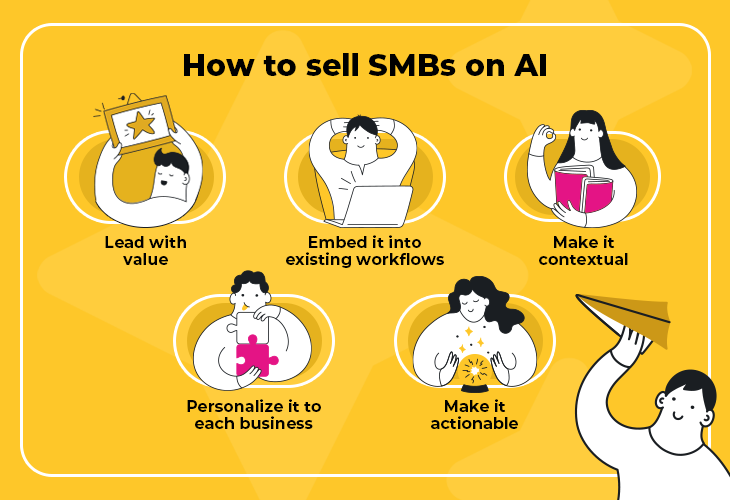
Bringing AI to SMBs requires a thoughtful, human-centered approach. Based on our findings and real-world experience, here’s how SMB-serving organizations can successfully introduce AI solutions.
Lead with value, not with technology
SMBs care about results, not just technology. They’re interested in solutions that help them run their businesses more efficiently, grow revenue, and improve customer relationships. The focus must always be on the business outcome: faster operations, better customer communication, easier task management. AI should be positioned as a helper, not a new system they have to master.
Embed AI into existing workflows
To reduce resistance, AI needs to be seamlessly integrated into the tools and processes SMBs already use. Pulling SMBs out of their familiar workflows to interact with a separate “AI tool” adds friction and risks abandonment. Ideally, AI should operate within the SMB’s day-to-day platforms.
Make AI contextual
AI recommendations should appear at the right moment and in the right context. For example, if the SMB receives a client message asking for a quote, an embedded AI agent could proactively suggest an estimate and offer to send it right then and there. In addition, if a sense of urgency is detected in the client message, additional measures such as an urgent visit can be suggested and scheduled. This kind of timely, contextual support turns AI into a trusted assistant rather than an intrusive distraction.
Ensure interoperability
SMB-serving organizations should look for platforms and solutions that support AI interoperability, allowing AI agents to access shared data and interact with other agents. Model Context Protocol (MCP) is quickly becoming the widely adopted standard allowing AI models to securely access and understand relevant business data from various tools in real time, improving the accuracy and usefulness of their responses. This enables AI agents to grow their effectiveness by directly tapping into the knowledge and context contained in underlying platforms and systems.
Personalize AI to each business
Each SMB is unique in size, industry, goals, and client base. AI solutions must adapt accordingly. When AI can learn from the specific business context, pulling from existing data, customer interactions, and historical patterns, it can deliver personalized, highly relevant advice. This moves AI from being “nice to have” to becoming mission-critical.
Make AI actionable
For AI to deliver real value to SMBs, it has to do more than advise; it needs to act. By automating repetitive tasks and simplifying processes, AI agents can dramatically reduce the manual effort SMBs invest in day-to-day operations. This frees up their time to focus on higher-impact work, like growing the business and serving customers.
The more an AI agent can handle behind the scenes, like drafting responses, scheduling tasks, generating estimates, and handling client communications, the less busywork lands on the business owner’s plate. This kind of task automation leads to higher productivity, faster execution, and better results.
But to fully unlock these gains, trust must be earned. That’s why laying out a thoughtful adoption path is essential. SMBs need time to understand how AI agents behave and confidence that they will act in their best interest. When that trust is built, it becomes the foundation for scaling into more proactive, fully autonomous AI support.
AI adoption path – how to get SMBs to trust AI
Trust is the cornerstone of successful AI adoption among SMBs. Without it, even the most powerful AI-driven solutions will struggle to gain traction. The key is to design an adoption path that respects customer needs, allowing them to gradually build confidence until they are ready to fully embed it into their ongoing workflows.
The optimal path for reaching trust and growing adoption starts with a co-pilot approach, where AI is assisting the user with performing tasks. It then continues with an agent approach, where the AI product performs specific actions on behalf of the user, leading to embedded AI workflows that leverage existing AI agents and apply ongoing learning and feedback loops to autonomously carry out complex, process-driven tasks.
Here’s the phased approach that works:
1. Make AI accessible and easy to use
AI agents should feel like a natural extension of what SMBs already do, not a brand-new system they should learn and master. Simplify access, minimize setup, and integrate AI features directly into familiar workflows. When SMBs find AI-powered solutions easy and intuitive, without a steep learning curve, their confidence builds naturally.
2. Start with controlled actions
In the early stages, SMBs want oversight. AI should suggest actions, not take them independently. For example, after receiving a customer inquiry, the agent proactively drafts a response, generates an appointment suggestion, or prepares an invoice. But instead of automatically sending or executing the action, the system allows the user to review and approve. This maintains human control, easing fears and allowing users to validate AI’s decision-making without risk.
3. Move to proactive, autonomous support when ready
Once trust is earned, AI can transition to a more proactive role. Over time, as SMBs see consistent quality and value, they’ll be more willing to let AI handle tasks on their behalf.
For example, AI could:
- Book appointments in response to client requests by selecting the best available time based on the request, service windows, and business availability.
- Follow up with new leads who inquired about a specific service, to answer their questions, provide relevant information and convert them to customers.
- Send actionable payment reminders to customers when they are most likely to make the payment, such as ahead of their next appointment, or at the time or day they have historically made payments.
- Respond to customer inquiries (text, chat, phone, etc.) when the business is unavailable, and hold complete and personalized conversations based on their history, including answering questions, scheduling appointments, and booking new services.
This progression from suggestive to proactive mirrors the natural trust-building journey SMBs need. Rushing them to full automation too soon risks backlash and rejection, while allowing them to gradually opt in to higher AI autonomy levels builds loyalty and stronger adoption.
How organizations can get SMBs to care about agentic AI
For SMB-serving organizations, offering AI solutions is only half the battle. The real challenge is getting SMB customers to care enough to adopt and stick with it. To succeed, you must move beyond simply adding more AI tools toward embedding AI into the customer experience in a way that feels natural, valuable, and indispensable.
Here’s how.
1. Tap into existing customer data and systems
AI agents shouldn’t require SMBs to start from scratch. Instead of asking users to manually train a new system, they should draw on publicly available data, such as website content, social media profiles, and other online sources. When possible, selectively integrating business data like service offerings, past bookings, or client communication history can give AI the context it needs to deliver relevant and effective support.
However, this must be done with care. Not all data should be shared freely, especially when it comes to personal or sensitive customer information. Integrations with tools like CRMs or email platforms should be selective and transparent, ensuring only relevant, permissioned data is used.
By combining responsibly sourced data with smart integration, AI can deliver value immediately without overstepping trust.
2. Embed AI into daily workflows
SMBs are short on time and patience. The best AI agents don’t pull users into a new interface or disrupt their flow. They are contextually activated at the right time, within the tools SMBs already use.
For example, when an SMB receives a customer inquiry, an agent can proactively respond in the same messaging channel. When a client cancels an appointment, another AI agent can immediately suggest rescheduling options without requiring customers to leave their calendar view.
Contextual, embedded AI keeps adoption high and feels like a helpful assistant working in the background rather than another “thing” to learn.
3. Eliminate AI silos
Today’s SMBs are overwhelmed by a flood of standalone AI agents, each focusing on a specific domain like marketing, scheduling, or finance. While each one may learn and improve over time, its growth is limited to the user interactions and data within that domain. This creates data and AI silos, prevents knowledge sharing across domains, and limits overall productivity gains.
When AI agents are connected through a shared platform, they can access a broader business context. Instead of working with narrow, domain-bound data, they can collaborate through a unified layer that shares insights and data across workflows. This allows each agent to make better decisions, adapt faster, and deliver smarter results.
An AI-powered solution that enables agents to operate in tandem, each mastering a specific domain but drawing from shared knowledge and contributing back to it, offers far more value than isolated agents ever could.
Consider adopting a framework such as MCP that supports data and knowledge sharing across platforms and agents.
4. Prioritize business-specific, personalized insights
SMBs don’t want generic advice. They want specific, personalized guidance based on their business context and specific situation. The more tailored an AI agent’s actions and suggestions are, the more likely SMBs are to trust and adopt it.
5. Serve recommendations at the right moment
Timing is critical. Random pop-ups or irrelevant advice damage trust. Instead, ensure that AI agents deliver recommendations when customers need them most, triggered by real actions, not arbitrary algorithms. For example, when the client reaches a milestone, they can be immediately served with the most relevant offer as the next step, not before, not after.
The winning AI-adoption playbook
Here is my playbook for getting SMBs to not only adopt but highly engage with AI solutions:
- SMBs are not looking for shiny new tech. Focus on delivering smarter services right inside their existing workflows.
- New tech is difficult to adopt. Not every SMB is AI-ready on day one. Embed agentic AI directly into everyday SMB workflows focusing on real business impact, and keeping the user in control.
- Transparency is key, and since AI, by its nature, is non-deterministic, ensure the outcome is crystal clear.
- AI silos are on the horizon. With a flurry of AI agents, each focusing on a specific domain, siloed islands of knowledge will soon form. Make sure those agents can communicate with others and access 3rd party data. Make your agent MCP compatible.
- Focus on providing a proven model: collect business context, activate AI at the right time, and deliver personalized, actionable recommendations.
- And lastly, the biggest AI adoption barrier is trust. SMBs need to build trust in the AI tools they use before they unleash them on their business. Give them initial control and allow feedback loops before making AI fully autonomous.
Final thoughts
The AI market is moving fast. Our latest research shows nearly half of SMB-serving organizations are already allocating between 20% and 50% of their development budget towards AI-related work, and 70% expect these AI investments to deliver an average 31% revenue growth.
AI solutions are no longer nice-to-have, they’re a must-have for any organization looking to boost its SMB business.
By adopting this AI-adoption playbook, you won’t just sell more, you’ll become indispensable to your SMB customers, helping them become more productive, grow and thrive.
























